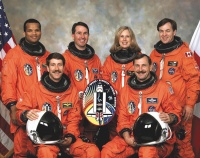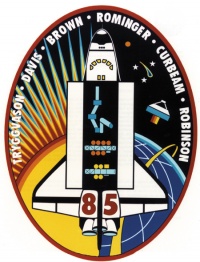STS-85
From The Space Library
 | |
| Organization | NASA-OfficeofSpaceFlight(UnitedStates) |
|---|---|
| Mission type | Astronomy,Engineering,Earth Science,Human Crew,Life Science,Microgravity |
| Launch date | August 7, 1997 |
| Launch vehicle | Space Shuttle |
| Launch site | Cape Canaveral, United States |
| COSPAR ID | 1997-039A |
| Experiments | Here |
| Alternate Names | 24889 |
| Additional Information | Here |
| Telecommunications Information | Here |
| Data Collection | Here |
| Payload Mass Up | 11331.64 kg |
STS 85 was the 23rd flight of the orbiter Discovery. Its primary mission was the deployment and retrieval of CRISTA-SPAS 2, a satellite designed to study Earths middle atmosphere along with a test of potential International Space Station hardware. The prime payload for the flight, the Cryogenic Infrared Spectrometers and Telescopes for the Atmosphere-Shuttle Pallet Satellite 2 (CRISTA-SPAS 2) made its second flight on the space shuttle and was the fourth mission in a cooperative venture between the German Space Agency (DARA) and NASA. CRISTA-SPAS 2 was deployed using the Remote Manipulator System (RMS) on day 1 of the mission and recaptured with the RMS on day 16. The STS-85 crew also supported tests of the Manipulator Flight Demonstration (MFD) investigation sponsored by NASDA, the Japanese Space Agency. MFD consisted of three separate experiments located on a support truss in the payload bay and was designed to demonstrate applications of a mechanical arm for possible use on the Japanese Experiment Module of the future International Space Station. The STS-85 crew was commanded by Curt Brown, on his fourth shuttle flight. The pilot was Kent Rominger on his third flight. The three mission specialists assigned to this flight were Jan Davis, Robert Curbeam, and Steve Robinson. Bjarni Tryggvason from the Canadian Space Agency served as payload specialist. Two other payloads in Discoverys cargo bay were the Technology Applications and Science-01 (TAS-01) and the International Extreme Ultraviolet Hitchhiker-02 (IEH-02). TAS held seven separate experiments that provided data on the Earths topography and atmosphere, studied the Sun's energy, and tested new thermal control devices. The four experiments comprising the IEH payload will study ultraviolet radiation from the stars, the Sun, and other sources in the solar system. Payload and experiments flying in the crew cabin area included the Southwest Ultraviolet Imaging System (SWUIS), a 7-inch imaging telescope that was pointed out of the orbiters windows by the crew primarily to observe Comet Hale-Bopp. Also in the crew cabin was the Bioreactor Demonstration System (BDS), a part of NASA's Medical Sciences Division Bioreactor program at Johnson Space Center and the Biotechnology Specimen Temperature Controller (BSTC). The BSTC is a cell culture incubator that is intended to ultimately lead to the use of microgravity to engineer tissues from individual cells. This investigation was planned to confirm the procedures necessary to conduct cell biology experiments on orbit and investigate the assembly of cardiac and smooth muscle cells in microgravity. STS 85 returned to Earth after 189 orbits and a mission duration of 11 days, 20 hours, 28 minutes, 7 seconds. Landing occurred at Kennedy Space Center 19 August 1997 at 11:07:59 UTC.

